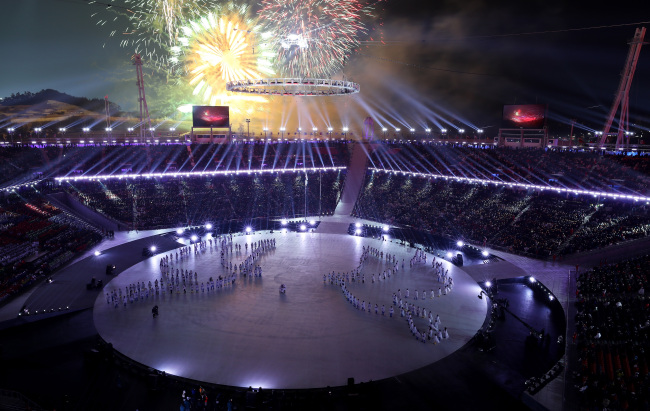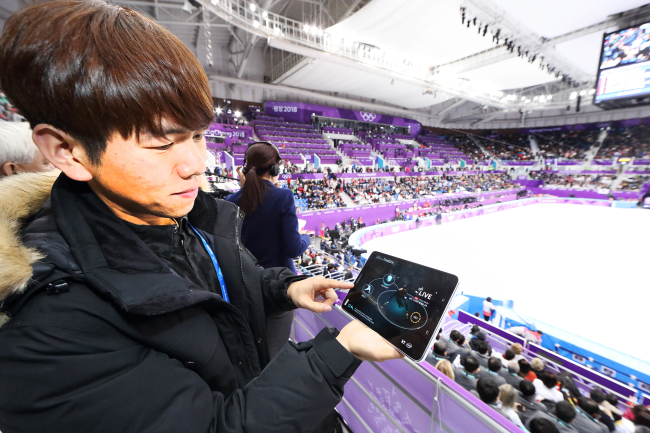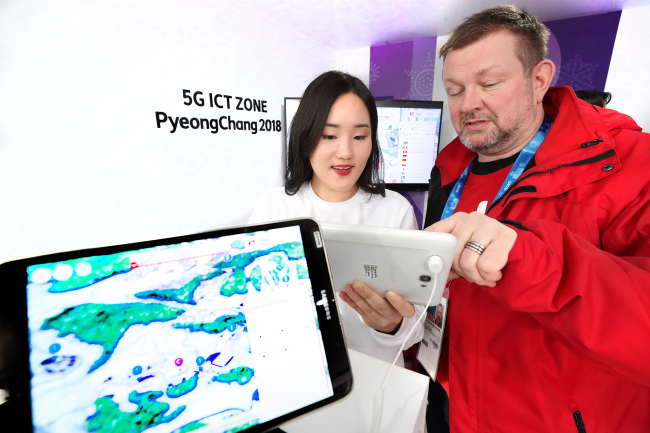On Feb. 9 the world was impressed by a giant peace dove that lit up the night sky with around 1,200 LED candles held by performers at the opening ceremony of the 2018 Olympic Winter Games.
The performance marked the very first in the Olympics’ history to use the fifth-generation wireless telecommunications network established by South Korean mobile carrier KT exclusively for the international sports event being held in a country ardently promoting ICT.
As an official telecom partner of the PyeongChang Olympics, KT prepared the LED candles to be controlled by a 5G-enabled tablet PC through its wireless network built at the main stadium.
The candles in the hands of performers were sophisticatedly turned on and off by the controller to the rhythms of music.
“Brightness and flickering of the candles had to be synchronized with the music and performers’ movements,” a KT official said. “This could be possible because of 5G’s super low latency and seamless connectivity in controlling the candles.”
KT has put all of its technological capabilities into preparing for what is nicknamed as “5G Olympics” over the past two years.
By partnering with Intel and Samsung Electronics, KT has deployed the world’s first large-scale 5G trial network in PyeongChang, with aims to offer the public an early glimpse of the new technologies and services that will be enabled by the next-generation network.
 |
Some 1,200 performers at the opening ceremony for the 2018 PyeongChang Winter Games create an illuminated image of a dove of peace by holding LED candles at PyeongChang Olympic Stadium on Friday. The LED candles were controlled by a 5G-enabled tablet PC through KT’s wireless network built at the main stadium for a more synchronized and systematic performance. Yonhap |
5G is designed to be at least 10 times as fast as today’s 4G Long Term Evolution network, promising download speeds of up to 20 gigabytes per second and a response time of less than 0.001 seconds.
The mobile carrier has planned to demonstrate how 5G can make watching sports a more interactive and immersive endeavor through four technologies enabled by the ultra-fast network -- sync view, time slice, 360 degree VR and omni view.
Time slice was first introduced to visitors at KT’s 5G exhibition space and four Olympic stadiums in PyeongChang and Gangneung over the weekend through streaming of speed staking, in which Korean skater Lim Hyo-jun won the first gold medal on Sunday, as well as figure skating and ice hockey games.
Time slice, applied in the ice arenas, is a 5G-dependent video streaming technology that lets viewers control the time, target and angle of what they are viewing. For instance, while watching a figure skater perform a jump, viewers can stop the screen to see that particular moment in different angles.
 |
A spectator watches a short track speedskating competition on a device using time slice, a 5G-dependent video streaming technology enabling viewers to control the time, target and angle of the video, with the competition captured at 180 degrees by some 100 cameras set up at Gangneung Ice Arena. Yonhap |
KT has installed 100 cameras at Gangeung Ice Arena for the time slice service.
Sync view is to be used for the bobsleigh games slated for the coming Sunday and Monday. The service will transmit live, real-time footage from the athletes’ point of view as they skid down the track at high speeds.
Viewers could feel as if they were the bobsleighing athletes during the sync view streaming, KT said.
KT attached tiny cameras on a total of 107 bobsleighs under the agreement with the International Olympic Committee and Olympic Broadcasting Services.
Omni point view was introduced during Saturday’s biathlon race.
It is a live broadcast service that hosts multiple live-feed videos at once. Viewers can choose the broadcast angle they want to view from, including personalized views of each athlete through GPS sensors attached onto their clothes and 5G module-adopted cameras. It is also being applied to cross-country skiing.
 |
KT’s Omniview service enables a live broadcast service that hosts multiple live-feed videos at once, allowing viewers to follow a specific athlete through precise GPS sensors attached to their clothes and 5G module cameras. Yonhap |
The 360 degree VR, to be showcased during the ice hockey and snowboarding tournaments, will let viewers watch the game live in VR by strapping on a 5G-connected VR headset.
In addition to these features, KT is also offering a number of 5G-based VR attractions at its Gangneung 5G promotion space. Visitors can play ice hockey or carry the Olympic torch in VR or take part in an Olympics escape room challenge while wearing VR headsets.
For those unable to physically make it down to Gangneung during the Olympics, KT is also operating a similar 5G experience space at its headquarters in Gwanghwamun of Seoul.
The Korean carrier will also be operating “5G buses” featuring various 5G technologies, as a promotional ride available to selected guests, it said.
“We are showcasing the world’s first ‘5G Olympics,’ running the first large-scale 5G network system in PyeongChang two years before the expected timeline,” said KT Chairman Hwang Chang-gyu during a joint ceremony on Jan. 31 at the company’s 5G promotion space in Gangneung.
After showcasing the pilot services based on non-standard 5G network, KT aims to move forward commercializing the network based on its PyeongChang specifications as early as the first half of 2019.
By Song Su-hyun (
song@heraldcorp.com)










![[Today’s K-pop] Blackpink’s Jennie, Lisa invited to Coachella as solo acts](http://res.heraldm.com/phpwas/restmb_idxmake.php?idx=644&simg=/content/image/2024/11/21/20241121050099_0.jpg)